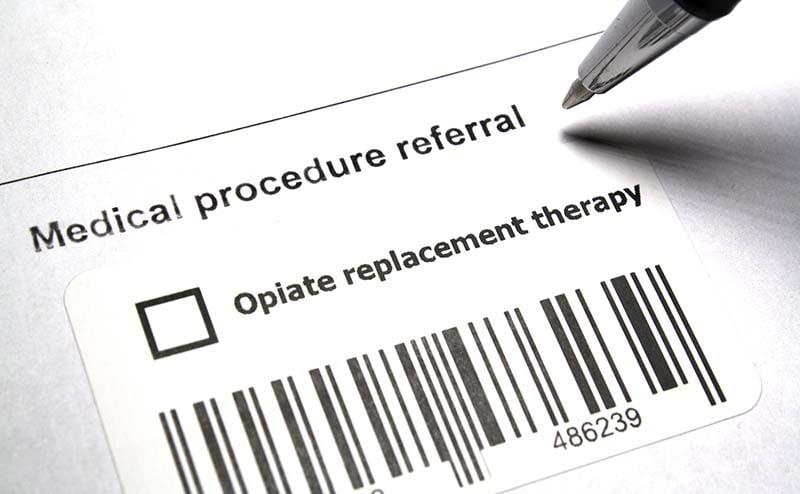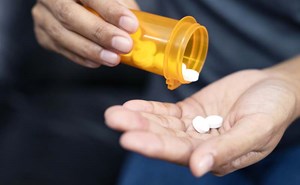Many advocates of expanding access to opioid use disorder (OUD) treatment, including ACEP, rejoiced at the repeal of the “X-waiver” requirement for prescribing medications for opioid use disorder (MOUD) at the end of last year. As you well know, ACEP advocated long and hard for the repeal of this barrier to treatment, which we believed contributed to the stigma around OUD. However, unfortunately, our work is not done. Far from it.
While the removal of the X-waiver now expands the universe of possible prescribers of MOUD from 130,000 to well over a million, that doesn’t mean that all million-plus practitioners are going to start prescribing this treatment overnight! Further, it also doesn’t mean that all pharmacies are going to start stocking buprenorphine—one of the main, and most effective, OUD treatments. In fact, we have already heard from many of you as emergency physicians that in some states not many pharmacies at all are stocking this medication, and patients have to go to multiple pharmacies to get their prescriptions filled (which also means that you have to spend a lot of time and effort helping your patients find a pharmacy that will fill your patients’ prescription). Unfortunately, as the number of eligible prescribers of buprenorphine grows, the supply shortages among pharmacies will also continue to rise.
So, what can be done to increase both the number of practitioners who are willing to prescribe buprenorphine as well as the number of hospital and community pharmacies willing to stock the medication? The answer, like all major health care issue, is a complex one—but ACEP is helping to lead the effort to come up with solutions!
We have been actively engaged with the key federal agencies responsible for MOUD regulatory policies: the Drug Enforcement Administration (DEA) and the Substance Abuse and Mental Health Services Administration (SAMHSA). While SAMHSA mostly regulates the administration of MOUD within Opioid Treatment Programs (OTPs), the DEA is responsible for regulating all the controlled substances that are administered, dispensed, and prescribed outside of OTPs (including outpatient facilities, hospitals, emergency departments, etc.).
ACEP was fortunate enough to be invited to a meeting with the DEA Administrator, Anne Milgram, last week to discuss this issue. Also attending were representatives from physician and pharmacy groups, as well as from federal agencies (the DEA, SAMHSA, and the Centers for Disease Control and Prevention). Through this meeting and other interactions with DEA and SAMHSA, we have identified what we believe to be the major remaining barriers to treatment. Some of these barriers have solutions—while, unfortunately, others are more difficult to crack.
As referenced above, one question we need to solve is how to get more practitioners who are willing to prescribe MOUD. During the DEA meeting, numerous stakeholders said that more education may be needed to help completely eliminate all the confusion and stigma that the presence of the X-waiver created for all those years. They specifically pointed to the mandatory 8-hour training requirement starting in June that every practitioner needs to complete in order to receive or renew their DEA license. ACEP did not support this mandatory educational requirement, but now that it’s the law, it could provide an opportunity for those who have not received any education around OUD treatment to get some training. The DEA and SAMHSA have yet to release details around this new educational requirement, but guidance is forthcoming.
The other key barrier to OUD treatment, as mentioned previously, is that many hospital and community pharmacies are not stocking buprenorphine. Pharmacies are claiming that distributors are placing quotas or caps on how much buprenorphine they can stock—and many have already reached their quotas.
Now, where do these quotas or caps come from? The DEA has claimed loudly that it does NOT set any quotas or limits on buprenorphine. In fact, Administrator Milgram has stated that if she had it her way, every pharmacy would stock buprenorphine. Thus, the issue seems to stem from the following:
- Issue # 1: SORS Database:Unfortunately, prescribing buprenorphine is flagged as a “suspicious order” according to current DEA regulations. On October 23, 2019, the DEA launched the Suspicious Orders Report System (SORS) Online, a centralized database required by the Substance Use-Disorder Prevention that Promotes Opioid Recovery and Treatment for Patients and Communities Act (SUPPORT Act). The SUPPORT Act requires that all DEA registrants that distribute controlled substances report suspicious orders to DEA. The SUPPORT Act does not directly specify the quantity of medication that is flagged as a suspicious order, so it is really up to the distributors to decide. According to the regulations, a suspicious order “may include, but is not limited to: an order of a controlled substance of unusual size; an order of a controlled substance deviating substantially from the normal pattern, and; orders of controlled substances of unusual frequency.” As referenced in a recent Politico article, due to the lack of clarity over what exactly constitutes a suspicious order, most distributors and pharmacies are being extremely conservative in their interpretation and requiring that most buprenorphine prescriptions be flagged as suspicious orders.
Possible Solutions: You can only imagine how a medication that is automatically labeled “suspicious” will deter practitioners from prescribing it and pharmacies from filling it. The last thing you would want is a DEA agent showing up at your door—even if you followed every single protocol that existed! One possible solution would be for the DEA to simply remove buprenorphine from the database and stop it from being flagged as a suspicious order. However, unfortunately the DEA has stated that it does not have the legal authority to do that. The DEA could also release specific guidance that specifies what exactly constitutes a suspicious order, clearing up the ambiguity that is causing all buprenorphine prescriptions to be flagged as suspicious orders. Another idea that ACEP relayed directly to the DEA during the meeting last week is to find some way to indicate that buprenorphine is a safe medication and would be used for the treatment of OUD. In other words, we asked whether there could be a way for the DEA to create a separate label within the SORS database that would switch buprenorphine from being reflected as a “red light” to a “green light.” The DEA will consider that option.
Finally, last month, ACEP submitted a letter to the Food and Drug Administration (FDA) asking the agency to consider adding buprenorphine to the list of essential medicines. The FDA list is often used as a reference on what EDs are required to stock, and therefore, if buprenorphine is on the list, it may help alleviate concerns about buprenorphine in any way being “suspicious.” - Issue # 2: Opioid Settlement Restrictions: Due to the role that drug manufacturers played fueling the opioid crisis, there have been major settlements across the country—forcing manufacturers to pay billions of dollars to states and agree to certain stipulations. As part of these agreements, there are limitations or quotas in place on how much controlled substances (including buprenorphine) can be distributed to pharmacies. This issue, which was highlighted in a New York Times article, is causing distributors to be even more restrictive in the distribution algorithms they establish for controlled substances. The result: pharmacies aren’t receiving the medications from distributors and then aren’t filling some prescriptions.
Possible Solution: Unfortunately, this issue falls under the category of “tough nut to crack.” According to the DEA, there is no federal action that can be taken, since these settlements have been conducted at the state level and distributors have the flexibility to establish quotas. And, as the New York Times article asserts, some state Attorneys General seem to be hesitant to reopen these agreements. - Issue # 3: Telemedicine: As referenced in a recent Regs and Eggs blog post, the DEA issued a waiver during the COVID-19 public health emergency (PHE) allowing practitioners to prescribe buprenorphine to patients with OUD via telemedicine even if they have never seen the patient in person. Although the waiver created a lot of flexibility in terms of telemedicine prescribing, the DEA has released a proposed regulation to establish a more restrictive permanent buprenorphine telemedicine policy.
Despite the waiver being in effect until the PHE ends on May 11, we have heard that some pharmacies are refusing to fill buprenorphine prescriptions done via telemedicine.
Possible Solution: The DEA could immediately issue a statement reiterating that buprenorphine can be prescribed via telemedicine. The issuance of the proposed reg may have caused confusion since it is more restrictive than the COVID-19 waiver. However, it is important to remember that it is a proposed reg—and no permanent policy has been established. Therefore, to alleviate confusion, the current policy of unrestricted buprenorphine prescribing via telemedicine could remain in place until the DEA establishes its final telemedicine policy.
Beyond addressing the barriers to buprenorphine, the DEA is also interested in increasing access to methadone treatment. While buprenorphine is more commonly initiated in the emergency department, methadone is a life-saving alternative treatment option that may be preferred by patients who have not been successful with buprenorphine in managing their OUD. Methadone is associated with high retention rates when flexibly delivered at low fixed doses and has been shown as equally suppressive of illicit opioid use. In all, research suggests that the sooner we can start patients on the right path and keep them engaged in treatment, the more successful their recovery can be.
However, there are numerous regulatory restrictions around the ability of physicians to prescribe methadone outside of OTPs for the treatment of OUD. Outside of OTPs, physicians could only prescribe methadone for pain management purposes. In some situations, practitioners are forced to put patients with OUD on a buprenorphine regimen even though they thought the patients would respond better to methadone treatment.
Interestingly, the “Three-Day Rule” may be a possible solution to expanding access to methadone (and buprenorphine) treatment. As a reminder, the “Three Day Rule” allows all practitioners to dispense up to three days’ worth of buprenorphine or methadone to patients for the emergency treatment of OUD. The policy pre-dated the X-waiver, and therefore, even though the X-waiver is repealed, the policy remains intact.
Since the Three-Day Rule is still in place, the policy gives practitioners an avenue to dispense methadone in emergency situations. However, as I discussed in a previous blog post, the DEA was supposed to issue a regulation that officially allow any practitioner with a DEA license to dispense up to three-days’ worth of medication at one time (initially, patients could only receive one-days’ worth of medication from a physician at a time, causing patients to have to come back to see their physician each day within the three-day period to receive their full regimen). The due date for the DEA to issue this regulation was June 2021. Instead of issuing a regulation, the DEA created a waiver where hospital systems and/or practitioners with a DEA license could email the DEA to ask for permission to dispense up to three-days’ worth of medication at one time. ACEP told the DEA at the meeting last week that it would be much clearer if the DEA issued a regulation officially implementing this policy. Since there is only a waiver in effect, some hospital administrators and compliance officers are still wary of allowing their practitioners to dispense methadone. There is also little consistency around how hospitals are allowing their physicians to dispense methadone. The DEA said that it would look into this issue further.
Well, that is a summary of all the major barriers to MOUD (there are probably many others) and the possible solutions that exist. ACEP will continue to make it a top priority to work with DEA and SAMHSA and at the state level to address these issues!
Before concluding, I do want to note that there has been some Congressional interest in this as well. Representative Paul Tonko (D-NY), a key sponsor of the legislation that eliminated the X-waiver, plans to send a letter to Administrator Milgram later today that requests that the DEA take action to help alleviate stakeholder concerns about stocking and dispensing buprenorphine.
Until next week, this is Jeffrey saying, enjoy reading your regs with your eggs!






